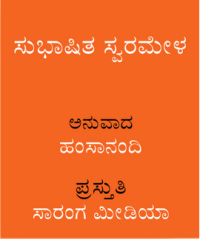Today, September 24th, 2014 is the first day of Navaratri – The Festival of Nine Nights. Navaratri, also known as Dasara in many parts of India, is a good time for classical music listeners – The music festival at Navartri Mandapam in Thiruvanantapuram and at Mysore Palace are well known. In some of the earlier years (2007, 2008, 2010… ), I have written about some musical compositions that are dear to me during the this ten day festival. I thought of reviving this tradition and make a few posts during this year’s Navaratri as well.
Since Navaratri is a celebration of the various aspects of Devi, I will confine to the compositions to those that are about Goddesses such as Parvati, Saraswati, Durga etc who are worshiped during these Nine Nights. Also, as a way of remembering the recently-departed ‘God of Mandolin’, U Srinivas, I will confine to only instrumental renditions of such compositions. I will try to point out to some interesting tit-bits about those compositions too.
First a couple of words about U Srinivas – I think we were plain lucky to have lived in the same time as this artist, who brought in an alien instrument and turned it into our very own, as far as Indian classical music is concerned. If you ask me, it is high time we call this instrument as Sri-Veena 🙂 . Although we tend to associate the word Veena with the Saraswati Veena (which is actually only as old as the early 17th century), the term Veena actually refers to a stringed instrument, with or without frets, which may be played using plucking or bowing etc. We have had Veenas such as Nagaveena, Dhanurveena (which were played using a bow), just like a modern day violin. We have the Chitra Veena (a.k.a. Gotuvadya), Rudra Veena and the like. Guitar which has been adapted for Hindustani music by Vishwa Mohan Bhat is being called as Mohana Veena, and why not call mandolin as Sri Veena ? Just a passing thought as I started out writing this post!
In the 18th century, Tanjavoor was a great center of music and arts. Syama Shastry, who is considered as one of the “Trinity” of Karnataka Sangeeta lived in Tanjavoor city. His compositions bear his signature as ‘Shamakrishna’. He was the priest of Bangaru Kamakshi temple in Tanjavoor, and often addresses his favorite deity as “Shamakrishna sodari” – the sister of Shamakrishna (Vishnu). Although numerically his compositions are lesser than those of Tyagaraja or Muttuswamy Dikshita, each of his compositions is indeed a gem.
During Sharabhoji’s reign (1777 AD – 1832AD), a musician named Bobbili Keshavayya, visited his court. Keshavayya was well known for challenging musicians. Since no other musician in Tanjavoor court were ready to face Keshavayya who was known for his expertise at singing pallavis with extremely complicated rhythmic structures, the responsibility fell on Syama Sastry.
(Picture courtesy: The Hindu, http://www.thehindu.com/todays-paper/tp-features/tp-fridayreview/carrying-on-the-legacy/article4463886.ece)
In the music-duel that followed, Keshavayya sang a pallavi in Simha nandana tALa, which Shama Sastry comprehended and reproduced. Now, it was Shama Sastry’s turn to challenge Keshavayya next day. That night during his prayers to Goddess Kamakshi, Syama Shastry sang a new composition in a brand new raga – Chintamani, pleading her to protect him at this critical moment (dEvI brOva samayamidE ati vEgamE vacci).
For the first day of Navaratri, the composition I want to share with you is this – “dEvi brOva samayamide” in Raga Chintamani, played on the mandolin by, who else but U Srinivas, and U Rajesh?
Wishing everyone a very happy time during this Navaratri.
-neelanjana




5 comments
Comments feed for this article
ಸೆಪ್ಟೆಂಬರ್ 24, 2014 at 3:29 ಅಪರಾಹ್ನ
sunarendra
Mysore dasara festivities upto 1956 is unparalleled.Navaratri in north is very different from how it is celebrated in Mysore and West Bengal..
.
LikeLike
ಸೆಪ್ಟೆಂಬರ್ 24, 2014 at 7:44 ಅಪರಾಹ್ನ
Mohan Santhanam
Actually Lalgudi Jayaraman in one of his speeches during a concert, has categorically said that the violin is NOT of western origin and proceeded to explain why.
Interesting facts about the Syama Sastri-Bobbilli Kesavayya revisited! Look forward to more!
Happy Navaratri!
Camp: Trivandrum
LikeLike
ಸೆಪ್ಟೆಂಬರ್ 28, 2014 at 11:47 ಅಪರಾಹ್ನ
neelanjana
Thanks Mohan for that information about LGJ. And enjoy your Trivandrum visit! Hope you’ll write about the concerts etc.
LikeLike
ಸೆಪ್ಟೆಂಬರ್ 25, 2014 at 12:50 ಅಪರಾಹ್ನ
Nine Nights: Day 2 | ಅಲ್ಲಿದೆ ನಮ್ಮ ಮನೆ
[…] 9/25/2014 is the second day of Navaratri. In the post I wrote yesterday for the first day of Navaratri, I was talking about how the term Veena was a generic term to any string instrument. But now, the […]
LikeLike
ಸೆಪ್ಟೆಂಬರ್ 27, 2014 at 3:52 ಅಪರಾಹ್ನ
Nine Nights: Day 4 | ಅಲ್ಲಿದೆ ನಮ್ಮ ಮನೆ
[…] day of Navaratri. In the first three days of this Navaratri, I wrote about a music composition of Syama Sastry, Muttuswamy Dikshita and Tyagaraja, who are popularly called the Trinity of Karnataka Sangeeta and […]
LikeLike